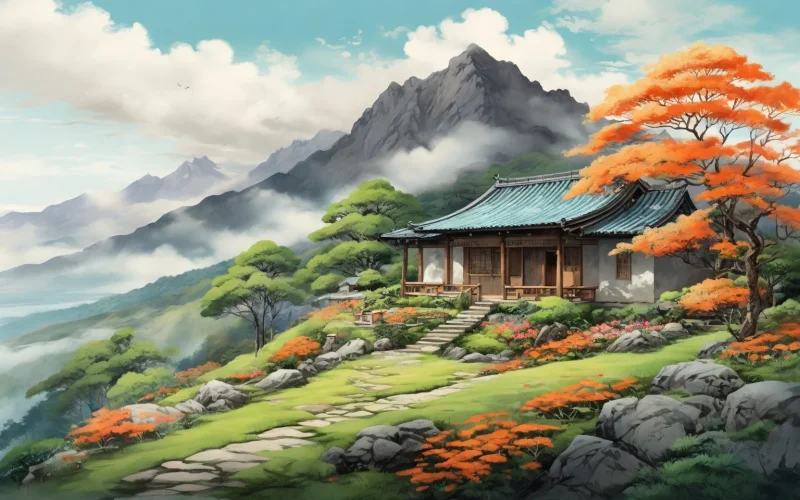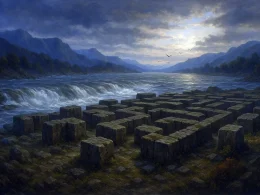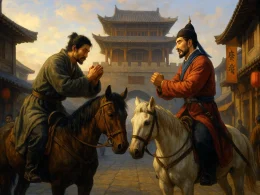Thatched with reeds and fenced with thorns, the temple stands,
Its steps in tiers of stone by rugged hands.
East valley’s laughter wakes west valley’s sound,
While clouds weep below, the peaks are sunlight-crowned.
Mice scurry from woodmen along moss-dark walls,
Apes swing on summits, shaking purple pines tall.
Yet one lone stream down to the ravine is thrown—
Through bamboo pipes, it fills the tea-maker’s own.
Original Poem
「题庐山寺」
马戴
白茅为屋宇编荆,数处阶墀石叠成。
东谷笑言西谷响,下方云雨上方晴。
鼠惊樵客缘苍壁,猿戏山头撼紫柽。
别有一条投涧水,竹筒斜引入茶铛。
Interpretation
Composed during the Zhenyuan era (785-805 AD) of the Tang Dynasty, this work emerges from a society still recovering from the An Lushan Rebellion. Though Ma Dai's official career remained unfulfilled, his literary talent flourished through nature-inspired poetry. This piece captures his visit to a Mount Lu temple, where the tranquil scenery stirred profound reflections, embodying his distinctive style of blending landscape with spiritual contemplation.
First Couplet: "白茅为屋宇,编荆数处阶墀石叠成。"
Bái máo wéi wūyǔ, biān jīng shù chù jiēchí shí dié chéng.
Thatched with silver grass, the roofs arise; Woven bramble thresholds meet stone-layered stairs in wise.
The opening lines depict the temple's rustic architecture—silver grass thatching and bramble-woven steps—establishing an aesthetic of unadorned purity. The layered stones suggest both natural formation and human reverence, merging artifice with mountain essence.
Second Couplet: "东谷笑言西谷响,下方云雨上方晴。"
Dōng gǔ xiào yán xī gǔ xiǎng, xià fāng yúnyǔ shàng fāng qíng.
East valley's laughter wakes west echoes' call; While clouds weep below, sunlight crowns the peak tall.
Here, Mount Lu reveals its spiritual geography: human joy reverberates through valleys, while the mountain itself exists in dual states—earthly suffering ("weeping clouds") and transcendental clarity ("sunlight crowns"). The vertical contrast mirrors Buddhist concepts of samsara below and nirvana above.
Third Couplet: "鼠惊樵客缘苍壁,猿戏山头撼紫柽。"
Shǔ jīng qiáo kè yuán cāng bì, yuán xì shāntóu hàn zǐ chēng.
Woodcutters startle mice scaling slate-gray scars; Apes swing purple tamarisks, shaking the sky's memoirs.
The mountain comes alive through its creatures: mice fleeing human intrusion, apes playing heedless of gravity. The "purple tamarisks" (紫柽), rare trees in classical lore, become celestial brushes painting the air—nature's artistry surpassing human craft.
Fourth Couplet: "别有一条投涧水,竹筒斜引入茶铛。"
Bié yǒu yītiáo tóu jiàn shuǐ, zhútǒng xié yǐnrù chá dāng.
A lone cascade plunges through ravines unseen, Then bamboo pipes guide it to the tea-boiler's sheen.
The finale unveils the hermit's alchemy: wild waterfalls tamed into tea ceremony. The "bamboo pipes" (竹筒) represent the delicate mediation between raw nature and refined culture—a metaphor for poetry itself distilling chaos into clarity.
Holistic Appreciation
This poem employs plain description, beginning with the simple architecture of Lushan Temple, moving to the echoing emptiness of mountain forests, then depicting the vertical distribution of clouds and rain, before finally presenting vivid scenes of human-nature interaction. Through this layered progression, it constructs a tranquil, dynamic, and poetic mountain world. The language flows naturally with rich imagery, and while not overly emotional, it reveals the poet's inner serenity and yearning for reclusive mountain life.
Without explicit declarations of intent, the poet subtly conveys his desire to retreat into nature and immerse himself in landscapes. Whether describing stone steps and thatched cottages or channeling stream water for tea, these are not decorative flourishes but genuine observations that reflect his personal ethos. Reading the poem feels like wandering through mountain woods—suddenly hearing valley echoes or glimpsing gibbon calls—freshly vibrant yet profoundly meaningful.
Artistic Merits
The poem's greatest strength lies in its simple yet vivid language. Ma Dai excels at using concise strokes to depict realistic scenes, such as the detail of "bamboo pipes slantingly channeling water into the tea kettle," which vividly captures the elegant beauty of mountain life. Scene and emotion blend seamlessly; the poet expresses his ideals not directly but through the stillness of forests and the dynamism of natural objects, achieving an artistic realm of "unity between self and nature." The imagery is exquisite, balancing movement and stillness, reality and abstraction, infusing the mountain landscape with quiet vitality. Its apparent simplicity belies deep resonance, showcasing Ma Dai's mastery of conveying emotion through scenery and expressing meaning via objects.
Insights
Through this poem, Ma Dai communicates an ideal of withdrawing from worldly chaos to embrace nature, reflecting his spiritual homecoming after political disillusionment. The temple's tranquility and nature's seclusion embody his longing for peace, reminding us to pause amid worldly pursuits and appreciate the beauty and purity of the natural world. The harmony between humans and nature in the poem also enlightens us: in turbulent times, perhaps the most precious treasures are unadorned authenticity and inner tranquility.
About the poet

Ma Dai (马戴) (c. 803 – 876), courtesy name Yuchen (虞臣), was a native of Quyang (present-day southwest of Donghai, Jiangsu) and a distinguished poet of the mid-Tang period. His poetry is characterized by its refreshing clarity and concise elegance, with particular mastery of five-character regulated verse (五律), embodying a unique aesthetic within Tang literary traditions.











